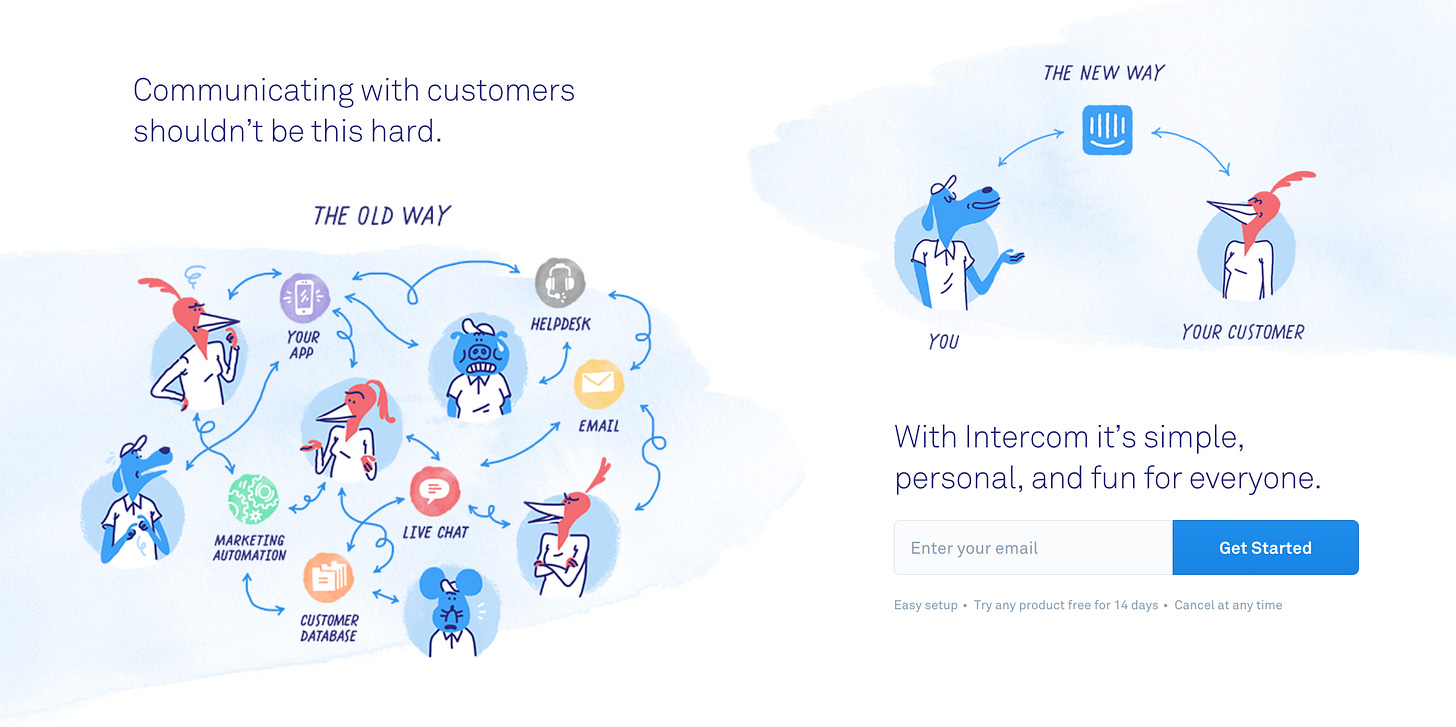Hello, I’m Hema, and welcome to my newsletter, First Impression. Each month, I write an in-depth post on positioning, brand, or GTM strategy for early-stage startups. Join startup founders, investors, and practitioners and subscribe to get the newsletter in your inbox.
Imagine this.
You tumble down a flight of stairs and twist your ankle. You’re in pain. You think you’ve broken it. You rush to urgent care. They ask you to fill out a lengthy form. Then you wait. Your ankle is the size of a lemon. Finally, a doctor sees you. She begins to tell you about her qualifications, years of experience, her specialization, the state-of-the-art OR, the latest equipment.
Now you’re in pain and irritated as hell. You want to scream. Smash something. Or, at the very least, hobble away to another urgent care before your ankle blooms to the size of a cantaloupe.
Gross exaggeration? For sure. But think about it for a second. How many times have you landed on a website to be hit by product demos, explainer videos, how-to’s, FAQs, and pages of tedious content about how the product works without a word acknowledging your pain?
Shocking, I know. But it happens a LOT.
In this post, I’m writing about the power of leveraging customer pain — behavioral, psychological, and emotional — to position and message your product to drive growth.
Tapping into customer pain
The first step in tapping into customer pain is understanding their current experience. Surveys and user interviews are popular ways to get at this. I wrote about this in these two posts: The Art and Science of Great Customer Interviews Part I and Shaping Product and Marketing with Customer Insights Part II.
But we must remember that users may not always consciously articulate every thought, emotion, or action. Our cognitive processes often operate automatically, and many of our actions occur without conscious awareness or reflection due to the selective nature of our cognitive system.
Two additional ways of getting at customer pain that I’ve found super useful are:
Contextual inquiry
Similar to ethnographic studies, here we observe customers in their natural environment so we can notice what they do on autopilot mode.
In one instance, during interviews with designers regarding their current workflows, a recurring pain point surfaced. They had considerable difficulty managing multiple versions of the same file.
Yet, it wasn't until I closely observed their work process that I grasped the fundamental motive driving the need to track these versions. Whenever they made a single modification to a design element within a file, they wanted this change to seamlessly propagate to all instances where that element was employed.
This insight fundamentally changed how we designed and messaged the product. It was not about just keeping track of stuff (which would have led to a very different file management product). It was about making sure all the versions were updated at the same time (a designer workflow-driven product).
Empathy mapping
The other method I find useful is empathy mapping. A map to visually represent customers’ thoughts, feelings, and behaviors to identify emotional pain, such as anxiety, stress, or frustration. Here’s an empathy map designed by David Gray, author of Game Storming, that I’ve used many times to capture what users see, say, feel, and do.
It’s important to only pay attention to what they do, we must also understand how they feel while doing that task. The pain users feel can be hugely leveraged for powerful messaging.
Leveraging pain to position yourself
Here’s a tech and a non-tech example of how customer pain can be used effectively to position a company while also depositioning the competitor or the current state of affairs.
This was Intercom’s homepage in 2016. Here Intercom uses pain messaging to deposition the current state of affairs — chaotic communications, multiple touch points, multiple apps, lack of context, and confusion. It’s simple but effective.
Gillette came out with a powerful campaign called “The Best Men Can Be” after the Me Too movement to encourage a different kind of masculinity. Despite some backlash, Gillette chose to lean into this progressive trend and leverage the pain felt by both men and women to tell a powerful brand story.
The 4.5 million views on YouTube tell you everything about how having a point of view can help Gillette to reclaim its advantage over incumbents like Dollar Shave Club.
Four pillars of pain narrative
When I think about leveraging pain to develop a narrative, I break it down into these four pillars:
Empathy
The first step is to show your customer that you understand their pain and genuinely care about it. This creates credibility in the minds of your customers. You’re going for the feeling “They really get me!”. Now they want to listen to what you have to say.
Desire
Ask any personal development or change management expert, and they’ll tell you that the desire for change is at the root of all transformation. Ask yourself the question, why is this painful current state no longer sustainable?
This is the moment in the Gillette video that shows vignettes of toxic masculinity. It’s hard not to look at those images and think, enough is enough.
Urgency
Every compelling story tackles a fundamental question: Why now? What makes this narrative relevant or pressing at this moment? Consider the Cinderella tale. Why now? Because the prince is hosting a grand ball to discover his future princess. Cinderella's desire to attend the ball provides the story with its driving force and urgency.
In the Gillette video, it’s the moment when the narrator says, “There is no going back.” The world has irrevocably changed, and we must change with it.
Action
Now that we’ve established the desire and urgency, where do we go with this? What is the alternative? This part of the narrative is what inspires your customer to take action. Do something. There is now a better way to do things.
In the Gillette ad, it is men holding other men accountable. Men leading by example. The boys watching today, the voice-over says, are the men of tomorrow.
Simple framework to develop pain messaging
Here’s a dead simple framework I’ve used to create effective pain messages.
Let's apply this simple framework for Peloton.
💁🏽♀️ Protip: I find it helpful to write the answers in the first person so you can really feel what it’s like to be in your customer’s shoes.
📜 What do they need to do? — I want to be healthy. I want to exercise every day. I want to feel good about myself.
🥺 How do they feel trying to do it? — I don’t always have the time. I can’t make it to the gym. I feel guilty for not exercising.
🧰 How does Peloton address this need? — I can get a good, sweaty workout without leaving my home.
💖 How does it make them feel? — I feel happy. I feel strong. I feel like I did something good for my body and mind.
Here are a few effective messaging from Peloton that speaks to the way we want to feel when using the product.










